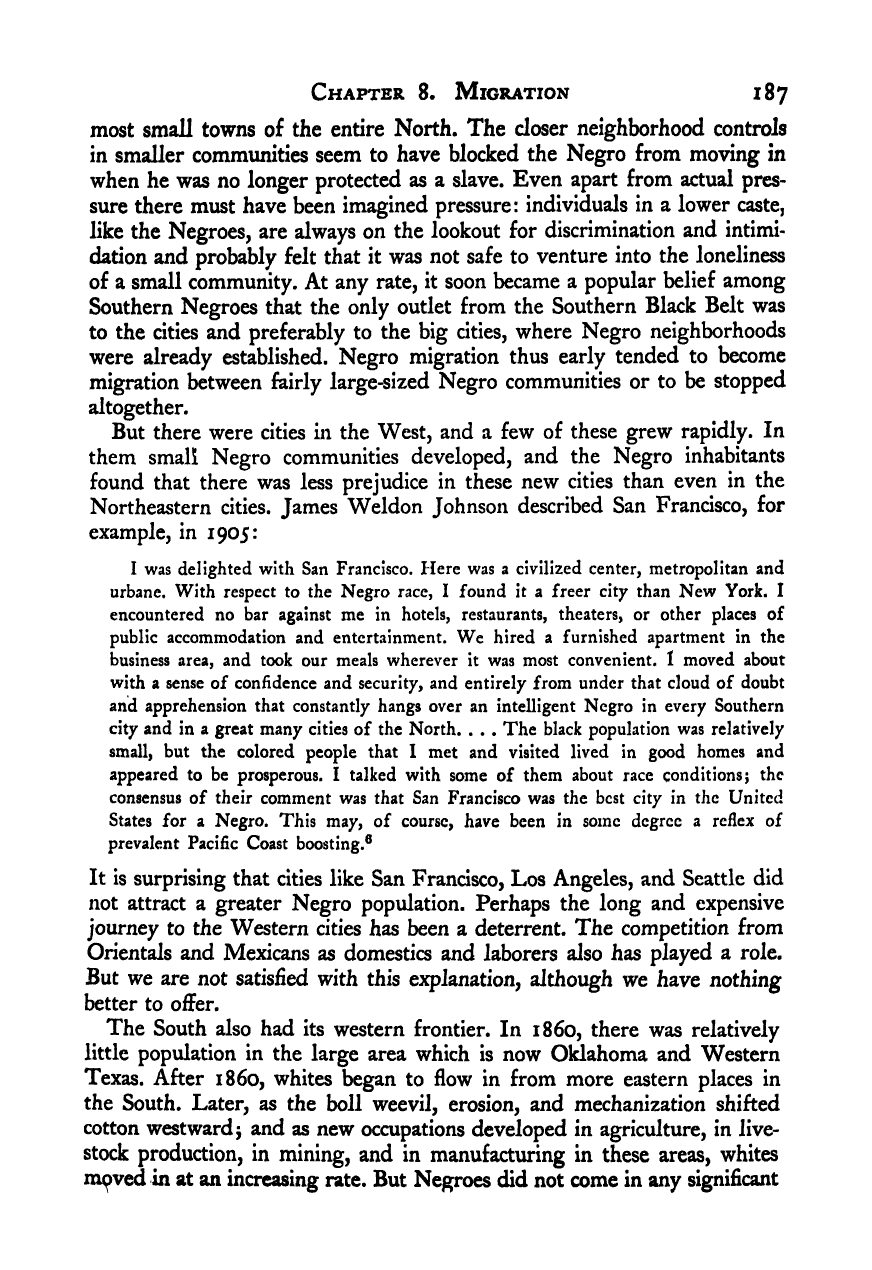Note: Gunnar Myrdal died in 1987, less than 70 years ago. Therefore, this work is protected by copyright, restricting your legal rights to reproduce it. However, you are welcome to view it on screen, as you do now. Read more about copyright.
Full resolution (TIFF) - On this page / på denna sida - III. Population and Migration - 8. Migration - 2. A Closer View

<< prev. page << föreg. sida << >> nästa sida >> next page >>
Below is the raw OCR text
from the above scanned image.
Do you see an error? Proofread the page now!
Här nedan syns maskintolkade texten från faksimilbilden ovan.
Ser du något fel? Korrekturläs sidan nu!
This page has never been proofread. / Denna sida har aldrig korrekturlästs.
Chapter 8. Migration 187
most small towns of the entire North. The closer neighborhood controls
in smaller commimities seem to have blocked the Negro from moving in
when he was no longer protected as a slave. Even apart from actual pres-
sure there must have been imagined pressure: individuals in a lower caste,
like the Negroes, are always on the lookout for discrimination and intimi-
dation and probably felt that it was not safe to venture into the loneliness
of a small community. At any rate, it soon became a popular belief among
Southern Negroes that the only outlet from the Southern Black Belt was
to the cities and preferably to the big cities, where Negro neighborhoods
were already established. Negro migration thus early tended to become
migration between fairly large-sized Negro communities or to be stopped
altogether.
But there were cities in the West, and a few of these grew rapidly. In
them small Negro communities developed, and the Negro inhabitants
found that there was less prejudice in these new cities than even in the
Northeastern cities. James Weldon Johnson described San Francisco, for
example, in 1905:
I was delighted with San Francisco. Here was a civilized center, metropolitan and
urbane. With respect to the Negro race, I found it a freer city than New York. I
encountered no bar against me in hotels, restaurants, theaters, or other places of
public accommodation and entertainment. We hired a furnished apartment in the
business area, and took our meals wherever it was most convenient. I moved about
with a sense of confidence and security, and entirely from under that cloud of doubt
and apprehension that constantly hangs over an intelligent Negro in every Southern
city and in a great many cities of the North. . . . The black population was relatively
small, but the colored people that 1 met and visited lived in good homes and
appeared to be prosperous. I talked with some of them about race conditions; the
consensus of their comment was that San Francisco was the best city in the United
States for a Negro. This may, of course, have been in some degree a reflex of
prevalent Pacific Coast boosting.®
It is surprising that cities like San Francisco, Los Angeles, and Seattle did
not attract a greater Negro population. Perhaps the long and expensive
journey to the Western cities has been a deterrent. The competition from
Orientals and Mexicans as domestics and laborers also has played a role.
But we are not satisfied with this explanation, although we have nothing
better to offer.
The South also had its western frontier. In i860, there was relatively
little population in the large area which is now Oklahoma and Western
Texas. After i860, whites began to flow in from more eastern places in
the South. Later, as the boll weevil, erosion, and mechanization shifted
cotton westward j
and as new occupations developed in agriculture, in live-
stock production, in mining, and in manufacturing in these areas, whites
mpved in at an increasing rate. But Negroes did not come in any significant
<< prev. page << föreg. sida << >> nästa sida >> next page >>